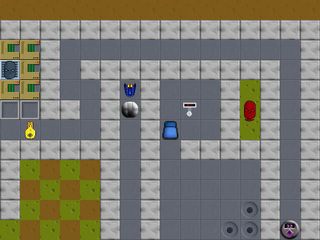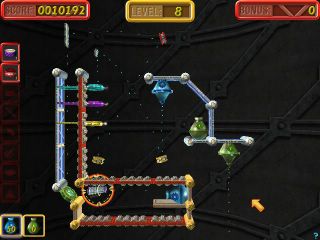Blackshift
Name: Blackshift
Author: Robin Allen
License: Freeware (donation requested for hints)
Website: http://www.foon.co.uk/blackshift/
A new update to Blackshift came out about a month ago. Over the last year, I have played it on and off. I would quickly get frustrated and put it aside. This time, I decided to buckle down and finish it off. You see, Blackshift is part puzzle game and part action game. The balance between puzzle and action in Blackshift is right on the border of what I consider acceptable. Actually, it is probably just over the line. Peaking at the hints page, you will see that the hint for level 36 is "go really fast." That proves my point pretty well.
Another problem with Blackshift is the mushy controls. When you hit an arrow key, your rover will sometimes move two space, which can cause you to move next to a bomb which then blows up. This means you have to start the level all over. This is a very annoying sequence of events. On some levels, there are checkpoints which allow you save your progress. You have to learn to quickly tap the arrow keys.
My next complaint is the usual, you have to complete the levels in order. To be fair, there is a way to skip really annoying levels in Blackshift. Every ten levels, there is a nuclear bomb hidden in the level. You can collect these nuclear bombs and used them to "solve" later levels. Also, if you want to cheat, open up the file progress.dat in a hex editor. By altering byte 5, you can skip a level. If you really want to cheat, you can add some nukes by altering byte 9.
Maybe I should describe the game. Blackshift is a Chip's Challenge like game. You control the blue rover robot thing. Your job to locate and destroy the frozen alien in each level. The levels are filled with bombs, keys, guns, missiles, mirrors, enemy robots, teleporters, and more. A big part of Blackshift is exploring and learning about all of the various items. The manual is initially vague.

Blackshift comes with 100 levels. While some require fancy finger work and careful timing, there are some good puzzles in the mix. This is why I kept coming back. As you work your way through the levels, new items are regularly introduced. The best part of the game is determining the effect of these items as they appear. A level editor is included.
While I cannot give it my full endorsement, Blackshift does have its moments. It is a very well-done, polished, and bug free game. Given that it is free, it is certainly worth a play.


